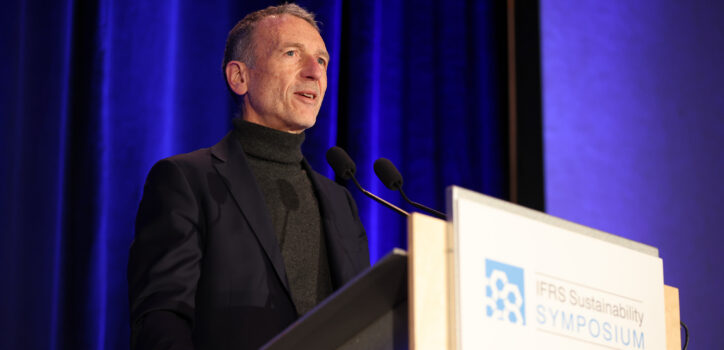Seven key takeaways from the IFRS Sustainability Symposium

On 17 February, more than 1,000 people from 45 countries convened in Montreal and online to discuss what’s next for investor-focused sustainability disclosure. Onsite in Montreal, the room was abuzz as businesses, investors, policymakers, regulators and other stakeholders engaged in meaningful discussion about the forthcoming standards from the ISSB. Read on for six key takeaways from the day’s sessions.
- ISSB Standards are nearing issuance
The day before the Symposium, the ISSB held a public meeting to make final decisions on the technical content of its first two standards, S1 (General Requirements) and S2 (Climate). After 20 sessions of redeliberation on the extensive feedback received during the consultation period last year, the board fully agreed on the final content of the standards and unanimously approved entering the next phase of standard-setting, the drafting and formal ‘balloting’ process. As such, the standards are on track to be issued at the end of Q2 2023.
- SASB Standards are a practical tool to implement S1
Industry-specific disclosures are required in each of the ISSB Standards. In addition, S1 requires that companies consider the SASB Standards to identify sustainability topics and metrics to disclose in the absence of a specific ISSB Standard. Also, S2 provides disclosures from the SASB Standards as illustrative guidance. As such, companies that already use SASB Standards will have a competitive advantage in applying the ISSB Standards. The SASB Standards will continue to be supported on a standalone basis by the ISSB for at least 4 years and realistically probably longer, with ISSB Standards that build on the SASB industry-based standards to follow. At the same time, a group of ISSB members—chaired by Jeff Hales, former Chair of the SASB Standards Board—has been established and tasked with developing recommendations for the ISSB related to the maintenance, evolution and enhancement of the SASB Standards.
- Global comparability remains paramount
The ISSB was established to create a global baseline of sustainability disclosure for investors, and speakers throughout the day reiterated the need to achieve global comparability. In the words of keynote speaker Mark Carney, UN Special Envoy for Climate Action and Finance and Co-Chair for the Glasgow Finance Alliance for Net Zero, “I think that the ISSB baseline is going to be decisive in terms of how cross-border capital is allocated because it’s comparable, reliable and consistent across jurisdictions…It would be exceptionally costly to a jurisdiction itself to not apply the core elements of S1 and S2.”
- Jurisdictions are actively considering the ISSB Standards
To realistically achieve this global baseline, jurisdictions must adopt the ISSB standards. The ISSB standards have built in proportionality, reliefs and guidance. This includes the instruction to “use reasonable and supportable information available without undue cost or effort”, and consideration of a company’s “skills, capabilities and resources” to determine the approach to providing information. Martin Maloney, Secretary General of IOSCO, gave his perspective on what the regulatory adoption process may look like. “My sense is we will see a number of lead jurisdictions who will move extremely fast. For us, it’s very important that they do it in a very professional way, as they have the ambition to do. I think we will then see the bulk of jurisdictions come in pretty quickly after that, you will then see a few who want to wait….the countries that work out how to manage the proportionality issue will move the most quickly and the ones who are most concerned about that will move the most slowly. But I expect adoption on quite a fast pace around the world.”
- Capacity building is critical to the ISSB’s success
During consultation on the ISSB standards, companies responded that there is a range of preparedness to use the standards, and that in particular, smaller companies and those in emerging markets need more support to apply the standards. In response, the ISSB decided to develop application guidance, illustrative guidance, and examples, and to introduce transition reliefs to reduce the burden on companies. These reliefs include phase-in periods, and basic/advanced reporting requirements based on a company’s resources (proportionate requirements).Rowe Price Vice President and Director of Corporate ESG Gabriela Infante emphasized how critical this is. “Not everyone’s sustainability reporting journey will look the same – that’s a fact. I will tell you candidly that not everyone has this figured out – this is not only normal, it’s natural. The fact that ISSB has pledged to publishing guidance, and to recognising there are different levels of preparedness and capability to apply S1 and S2, is really crucial for this work to ultimately be embraced globally.”
- Work to advance integrated reporting remains underway
Concepts in the Integrated Reporting Framework are embedded in S1, and work between the ISSB and IASB is underway to more closely integrate the Integrated Reporting Framework and the IASB’s Management Commentary. Andreas Barckow, IASB Chair, commented on this: “It is widely acknowledged that integrated reporting is a step forward from traditional accounting, and obviously the more we can keep that family close to us, the more inspirational this entire journey becomes.”One recent step forward towards integrated reporting is the ISSB’s decision to draw on concepts in the Integrated Reporting Framework to describe the connectivity between sustainability and financial value creation, articulating how a company’s ability to deliver financial value to investors is inextricably linked to the stakeholders with whom it works and serves, the society in which it operates and the natural resources upon which it draws. The ISSB will shortly consult on connectivity between sustainability disclosures and financial statements, including considering how to incorporate and build upon the Integrated Reporting Framework and the IASB’s Management Commentary.
- Many stakeholders have enabled the ISSB to make significant progress
In his opening keynote, ISSB Chair Emmanuel Faber reminded us why the ISSB is developing these standards and thanked the many stakeholders that are helping deliver them. Watch it here.
—
Thank you to everyone who joined us for the inaugural IFRS Sustainability Symposium. If you’re interested in future events, save the date for the IFRS Sustainability Integrated Reporting Conference on 12 June in Frankfurt and the IFRS Foundation Conference on 26 – 27 June 2023 in London. To stay updated on the ISSB’s work and opportunities to get involved, subscribe for news alerts.
